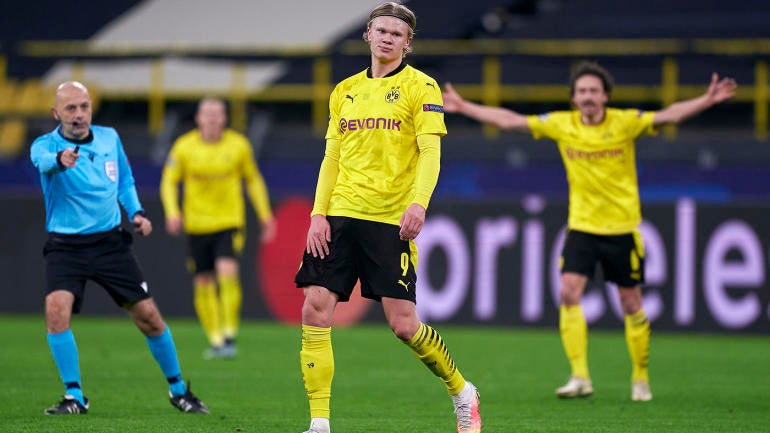
In a rare scenario that will go down in the books for the football community, Massimiliano Irrati, the video assistant referee for Borussia Dortmund's 2-2 draw against Sevilla in the second leg of the UEFA Champions League round of 16 (Dortmund advanced 5-4 on aggregate), found himself in a situation where his vast VAR experience was put to work during a six-minute span. And we all got an education in advanced VAR usage.
Three VAR recommendations were given to head referee Cuneyt Cakır, who disallowed a goal, awarded a penalty kick and yellow card, and had the penalty retaken.
You can watch the replay of the match on Paramount+, and my video breakdown of the calls at the top of the article. Let's break everything down for you.
7 minutes of chaos summed up in 22 seconds by @ErlingHaaland — in his own words 😬☠️ pic.twitter.com/2OstbpmpDR
— Champions League on CBS Sports (@UCLonCBSSports) March 10, 2021
Haaland's disallowed goal
So let's begin where everyone got lost.
- Haaland scored in the 48th minute when he powered through Fernando to put the ball in the back of the net and the referee's on-field decision was a valid goal.
- Under the VAR process, every goal is automatically checked starting from the attacking phase of play to see if any offenses would disallow the goal.
- Irrati confirmed through video and made a recommendation to Cakir to disallow the goal as Haaland fouled Fernando by going through his back instead of a fair shoulder challenge.
- Cakir, after reviewing the video, accepted the recommendation and disallowed the goal.
- Before Cakir could leave the video monitor, he would have to review another VAR recommendation that happened right before Haaland's goal that was unable to be reviewed before Haaland's goal because of the immediate nature of the plays.
It's important to note that under VAR process, Irrati was first required to show Cakir the foul committed by Haaland on Fernando because if Cakir did not agree with the recommendation that a foul occurred, then Haaland's goal would have stood and that would have been the end of the VAR discussion.
Penalty kick and yellow card
Once referee Cakir disallowed the goal, the next step would be to check the potential penalty kick with Haaland and Kounde.
- There was a potential hold by Kounde on Haaland in the 47th minute in the penalty area preventing Haaland from being able to play the ball which was crossed in.
- Cakir's on-field decision was no foul on Haaland, play on.
- Similar to goal situations under the VAR process, every potential penalty - given or not given - is automatically checked.
- Irrati provided the recommendation that prior to Haaland's goal there was a penalty kick that should have been given when Kounde fouled Halland on the cross by holding him and preventing him from playing the ball.
- Upon review, Cakir agreed a penalty kick should have been awarded with a yellow card to Kounde for holding.
Penalty retake

This brings us to the easiest of the VAR recommendations: A retake of the penalty kick.
- The video is clear that Sevilla goalkeeper Yassine Bounou had his feet completely off the line before the kick was taken by Haaland and Bounou made the save.
- When VAR is involved, the protocol is now to allow VAR to review and confirm whether the goalkeeper has stepped off the line since it is a factual decision.
- It's then a referee's decision to determine whether a keeper stepping off the line impacted the play -- a subjective decision.
- Here, it's clear that Bounou's infraction impacted the play as he saved Haaland's kick and the ball remained in play and changed possession.
- Since the ball was still in play, Irrati recommended to Cakir at the next neutral moment or at the next stoppage of play that the penalty would need to be retaken.
- It was only until the 52nd minute did Cakir have his first opportunity to stop play during a neutral time and inform the players a re-take was necessary.
Erling Haaland says revenge is best served from 12 yards out 😂 pic.twitter.com/YrN4q33KLV
— Champions League on CBS Sports (@UCLonCBSSports) March 10, 2021
How far back can VAR go to review plays?
The period of play that a VAR is able to review is called "the attacking phase of play," also known as APP, which leads directly to the decision/incident being reviewed and can include how the attacking team gained possession of the ball in open play. Once a play has restarted, the APP resets and a VAR would not be able to review/check an incident unless there is a case of mistaken identity for misconducts or a potential sending off offense related to violent conduct, spitting, biting, or an extremely offensive, insulting and/or abusive gestures.
Situations like this are rare in the sport. A double VAR review is like finding a unicorn at the end of the rainbow with a pot of gold next to it. Barely does it happen where there is such immediacy of time in which two reviews are necessary (approximately a minute between each incident) and the referee was not able to stop live play in neutral zone/situation after the initial penalty decision in the 47th minute to avoid the second review in the 48th minute.
It was excellent work by the officials to stay focused on the details of the process in this rare scenario, one we usually only get to talk about as a hypothetical during VAR training. The clean use of the VAR process resulted in the correct decisions by the officiating team under the high level of pressure and magnitude of the round of 16 in Champions League. It reinforces that some of the best referees in the world work in the Champions League and make incredibly difficult scenarios look easy to the football world.





















